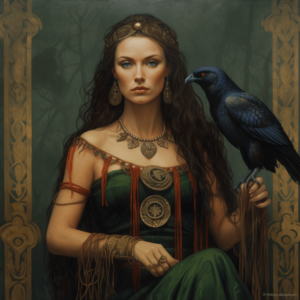Irish mythology is full of heroic tales, epic battles, and gods and goddesses. Central to these myths is the figure of the Morrigan, a mysterious and powerful deity whose influence spans across centuries.
Origins of The Morrigan
The Morrigan’s origins can be traced back to the ancient tribe of gods and goddesses known as the Tuatha Dé Danann. These supernatural beings inhabited Ireland before the arrival of the Celts and were believed to possess great knowledge and magical powers. The Tuatha Dé Danann are thought to have influenced the pantheon of Celtic deities, with the Morrigan as one of the key figures.
The name “Morrigan” is derived from the Old Irish words “Mór Ríoghain,” which translate to “Great Queen” or “Phantom Queen.” Some scholars argue that her origins predate the arrival of the Celts in Ireland, suggesting that she may have been an indigenous goddess with roots in the pre-Celtic population. Evidence of her pre-Celtic origins can be found in the numerous megalithic monuments, such as the cairns at Loughcrew and the passage tomb at Newgrange, which are associated with the Morrigan.
One of the most intriguing aspects of the Morrigan is her triple nature. She is often depicted as a trio of sisters—Badb, Macha, and Anann (also known as Nemain)—who each represent different aspects of the goddess. Badb, whose name means “crow” or “raven,” is associated with war and battle, while Macha symbolizes sovereignty and the land. Anann, also known as Nemain, is the aspect of the Morrigan connected to fertility, life, and death. Due to this, the Morrigan goddess has been referred to as the Irish goddess of death.
The concept of the triple goddess is not unique to the Morrigan, as it can be found throughout Celtic mythology. This triadic nature reflects the Celtic belief in the power of threes, with the number three often symbolizing unity, balance, and the interdependence of different forces.
The Morrigan in Irish Mythology and The Irish Goddess of Death
The Morrigan is a central figure in several key Irish myths and legends, where her powers and influence are on full display. One such tale is the Battle of Mag Tuired, in which the Morrigan plays a pivotal role in the defeat of the Fomorians, a race of supernatural beings who were seen as enemies of the Tuatha Dé Danann. In this story, the Morrigan uses her powers of prophecy and shape-shifting to incite fear and confusion among the Fomorians, ultimately leading to their downfall.
Another significant tale involving the Morrigan is the Cattle Raid of Cooley (Táin Bó Cúailnge), a central epic of Irish mythology. In this story, she encounters the hero Cú Chulainn and, after being spurned by him, proceeds to hinder his progress in the ensuing battles. The Morrigan demonstrates her shape-shifting abilities by transforming into various animals to distract and deceive Cú Chulainn, showcasing her power as a goddess of war and cunning.
Perhaps the most famous story involving the Morrigan is her prophecy regarding the death of Cú Chulainn. She appears to the hero in the form of a beautiful maiden and offers him her love, but he rejects her advances. In response, the Morrigan foretells his impending doom, and true to her prophecy, Cú Chulainn meets a tragic end. The tale underscores the Morrigan’s role as a goddess of prophecy and fate, as well as the consequences of defying her will.
In addition to these stories, the Morrigan’s relationships with other gods and mythological characters reveal her complex nature and influence within the Celtic pantheon. For example, she is sometimes seen as the wife or consort of the Dagda, the chief god of the Tuatha Dé Danann, with whom she shares a connection to the land and sovereignty. Additionally, the Morrigan is often linked to other warrior goddesses such as Scáthach and the Valkyries of Norse mythology, further emphasizing her role as a powerful figure of war and death.
The Symbolism and Powers of the Morrigan
The Morrigan’s multi-faceted nature is reflected in her diverse range of associations and powers. As the Irish goddess of death, war, and sovereignty, she embodies the destructive and transformative aspects of life. She is often depicted as a harbinger of doom, using her prophetic abilities to foretell the outcomes of battles and the deaths of heroes. Yet, the Morrigan is not solely a figure of destruction; she also represents the regenerative power of the land and the cyclical nature of existence.
Her shape-shifting abilities further emphasize her transformative nature. The Morrigan is known to assume the forms of various animals, particularly the raven or crow, which are symbols of death, transformation, and wisdom in Celtic mythology. By taking on these forms, the Morrigan exemplifies her connection to the mysteries of life and the unknown.
The Morrigan is also associated with feminine power and fertility. As a triple goddess, she represents the different stages of womanhood—maiden, mother, and crone—reflecting the cyclical nature of life and the importance of balance. Her role as a goddess of sovereignty, in particular, highlights her connection to the land and the power of the feminine in ruling and protecting the people.

The Morrigan in Modern Culture
In recent years, there has been a resurgence of interest in Celtic mythology The Morrigan takes center stage as a compelling and enigmatic figure. Her stories have inspired various works of literature, music, and art, with contemporary creators drawing upon her rich symbolism and evocative imagery to explore themes of power, transformation, and the mysteries of life.
Moreover, the Morrigan has found a place within modern neopaganism and spiritual practices. She is seen as symbol of female power and strength. Because of this, she is often used by practitioners seeking to connect with their inner strength and wisdom. The Morrigan’s associations with the land and the cycles of life also resonate with those seeking to live in harmony with nature and embrace the transformative aspects of existence.

